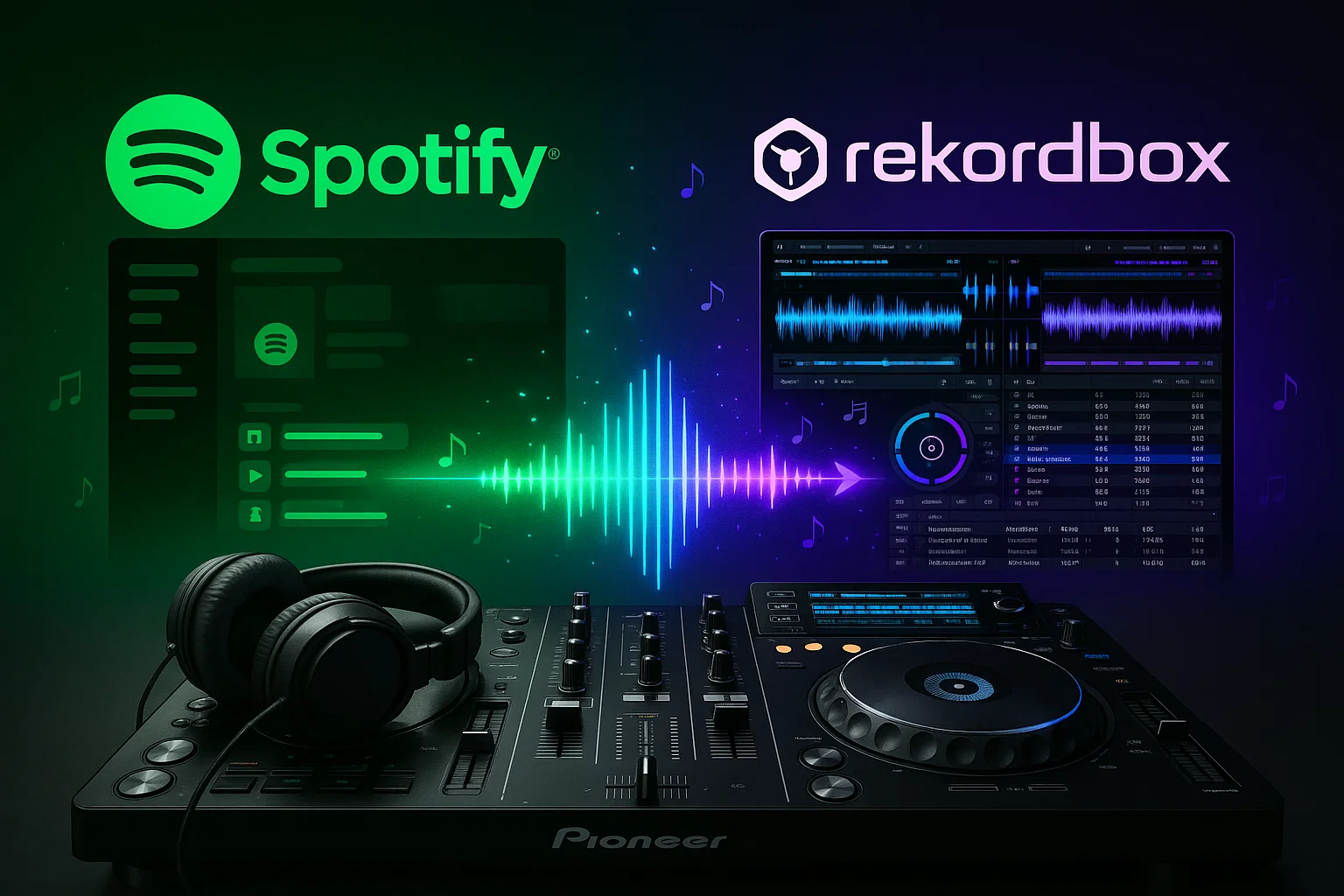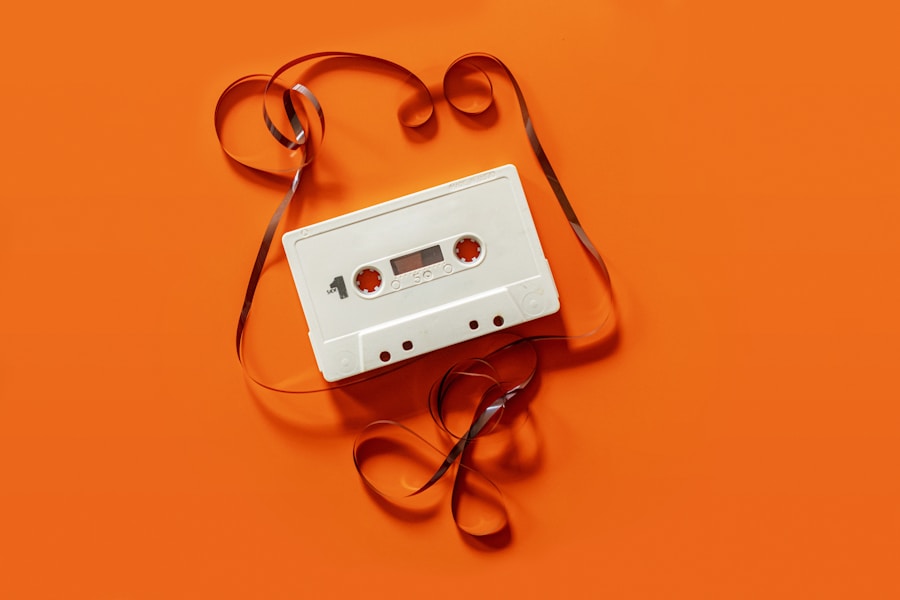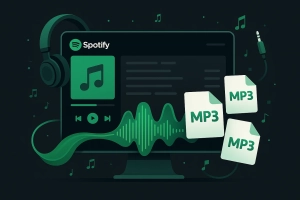Ever spent hours curating the perfect Spotify playlist for your next gig, only to find out Rekordbox won’t touch it?
Yeah, me too. That moment when you realize Spotify’s got 100 million tracks but Rekordbox treats them like they don’t exist? Frustrating doesn’t even cover it.
The problem’s simple: DRM protection and format incompatibility. Spotify locks everything down. Rekordbox wants MP3s and WAVs. They just don’t speak the same language.
But here’s the thing—I’ve figured out multiple workarounds that actually work. Not theory. Not “maybe this’ll work.” Real solutions I use for actual gigs.
In This Article:
Why Doesn’t Rekordbox Play Nice with Spotify?
Before jumping into solutions, let’s get real about what’s actually blocking you here.
The End of Spotify DJ Integration
In July 2020, Spotify pulled the plug on third-party DJ app integration. Not just Rekordbox—Traktor, Serato, the whole gang lost direct Spotify access overnight.
Free or Premium? Doesn’t matter. Neither gives you playlist access in Rekordbox. Frustrating? Absolutely.
Technical Barriers You Need to Know
Spotify encrypts all music with DRM (Digital Rights Management). They store files in Ogg Vorbis format. Rekordbox? Doesn’t recognize that format at all.
What does Rekordbox accept? MP3, AAC, WAV, FLAC, ALAC, and AIFF. Standard stuff.
The solution? Convert those Spotify tracks into something Rekordbox can actually read. Simple as that.
The Method I Swear By: Converting Spotify Tracks
Look, I’ve tried every workaround out there. This one? It’s the winner for a reason.
Why I keep coming back to conversion: You get offline access, you’re not married to a subscription, and you actually own your music library.
Why This Beats Every Other Option
Here’s the thing about converting to local files—they’re yours. Load them onto USB drives for CDJs. Back them up to external drives. Use them across any DJ software you want.
I learned this lesson the hard way at a festival last year. Venue WiFi died mid-set. My streaming-dependent backup DJ? Panicking. Me? Smoothly switching to my offline library like nothing happened. That’s when it clicked.
The Tool That Actually Works: Cinch Audio Recorder
After burning through a dozen recording tools (some terrible, some okay), Cinch Audio Recorder ended up being the one I actually kept using.
Why? It just… works. No drama, no weird bugs, no “oops, your file got corrupted” surprises.
One-Click Batch Recording
Cinch is remarkably simple to use. Click Record, play your Spotify playlist, and Cinch automatically splits each track into separate files. No more dealing with giant audio files you have to chop up manually.
Multiple Format Support
Choose your output format based on gig requirements. I typically use MP3 at 320kbps—the quality is indistinguishable from lossless on most club systems, and you save massive storage space. A 4-minute track in WAV might be 40MB, while 320kbps MP3 is only 9MB.
Automatic ID3 Tag Detection
Cinch automatically captures artist names, track titles, album artwork, and genre tags from Spotify. When you import these files into Rekordbox, everything shows up perfectly organized—no manual tagging required.
Ad Filtering for Free Spotify Users
If you’re using Spotify Free, Cinch automatically removes audio ads. Your recordings come out as pure music, ready for Rekordbox.
Silent Recording Feature
Cinch can record while your computer is muted. Queue up a playlist to record overnight, mute your speakers, and wake up to a fresh batch of Rekordbox-ready tracks.
Real DJ Workflow Example
Last month I had a wedding with 200 tracks spread across different Spotify playlists. I compiled everything into one master playlist, launched Cinch, configured settings (MP3, 320kbps), and hit Record. Two hours later, I had 215 perfectly tagged MP3 files ready for Rekordbox.
The father of the bride specifically complimented how crisp the music sounded through the venue’s system. That’s when I knew I’d found the right tool.
Step-by-Step: Recording Spotify for Rekordbox
Step 1: Download and install Cinch Audio Recorder
Step 2: Launch Cinch and configure settings:
- Format: MP3
- Bitrate: 320kbps (maximum quality)
- Output Folder: Choose a memorable location
- ID3 Tags: Enable automatic detection
Step 3: Open Spotify and queue your playlist or album
Step 4: Click Record in Cinch, then play your Spotify tracks
Step 5: Cinch automatically:
- Records audio directly from your sound card
- Splits tracks based on silence detection
- Captures ID3 metadata from Spotify
- Removes ads (for Spotify Free users)
Step 6: Access your files in Cinch’s Library tab. Right-click any track and select “Open File Location”
💡 Pro Tip:
I always record at 320kbps MP3. I’ve done blind listening tests comparing these files against WAV on professional systems—nobody could tell the difference. WAV files are 10x larger, and when building a library of thousands of tracks, storage efficiency matters.
Other Tools I’ve Tested (Quick Rundown)
Look, I’ve tried pretty much every converter out there. Here’s the honest breakdown:
| Tool | Speed | Best For | Deal-breaker |
|---|---|---|---|
| Cinch Audio Recorder | Fast batch recording | Multi-platform (Spotify, Apple Music, Tidal, etc.) | ✅ None – it’s my daily driver |
| NoteBurner | 10x speed | Spotify-only users | One platform only |
| ViWizard | Similar to NoteBurner | Clean interface lovers | Limited to Spotify |
| DRmare | Good batch processing | Bulk conversion | Less versatile |
What makes Cinch different? It’s the only tool I use that handles any streaming platform. I record from Spotify, Apple Music, Tidal, and even SoundCloud using the same software. For DJs who pull music from everywhere (like, all of us), that’s huge.
Value-wise? The ad-filtering alone pays for itself if you’re on Spotify Free. And honestly, I’ve even used the ringtone maker to create custom intro drops and transition effects. Not gonna lie, that feature surprised me.
Getting Your Converted Tracks Into Rekordbox
Alright, you’ve got your Rekordbox-ready files from Cinch. Now let’s actually get them into the software.
Three ways to do this. Pick whichever feels right for your workflow.
Three Import Methods on Desktop
Option A: Direct Folder Import (Fastest)
- Open Rekordbox and click the computer folder icon in the left sidebar
- Navigate to your Cinch output folder
- Click a track or folder—it appears in Rekordbox’s collection
- Configure analysis settings when prompted
Option B: File Menu Import
- Go to File > Import in Rekordbox
- Choose Import Track, Import Folder, or Import Playlist
- Browse to your music location
- Click OK to import
Option C: Via iTunes/Music App
- Import Cinch recordings into iTunes first
- In iTunes Preferences, enable “Share iTunes Library XML with other applications”
- In Rekordbox, click the iTunes icon in the sidebar
- Browse iTunes playlists—Rekordbox syncs automatically
⚠️ Critical Mistake to Avoid:
I once dragged 500 unanalyzed tracks into Rekordbox right before a Friday night gig. The software immediately started analyzing all of them. Froze my entire interface for 10 minutes straight. Nearly had a panic attack.
Learn from my stupidity: Go to File > Preferences > Analysis and enable “Analyze newly imported tracks in background” before adding large batches. Trust me on this one.
Importing on Rekordbox Mobile
For mobile DJing:
- Connect your phone to computer via USB
- Transfer Cinch recordings to your phone’s music folder
- Open Rekordbox mobile app
- Tap arrow icon (top-left) > Import songs > All songs
- Select your transferred tracks
- They appear in Collection, ready to use
Other Ways DJs Handle This (If Conversion Isn’t Your Thing)
Conversion is what I do, but hey—different strokes for different folks. Here are the other routes people take.
Playlist Transfer Services (For Streaming-Only DJs)
If you’re committed to streaming and subscribe to services Rekordbox supports—like Tidal, SoundCloud Go , Beatport Streaming, or Beatsource—playlist transfer tools can bridge the gap.
Tools like Soundiiz, TuneMyMusic, and Stamp act as intermediaries, transferring your Spotify playlists to Rekordbox-compatible platforms.
How it works:
- Visit Soundiiz and create an account
- Connect both your Spotify and Tidal accounts
- Select your Spotify playlist
- Click transfer and choose Tidal as destination
- Confirm track matching and complete transfer
- Open Rekordbox, connect to Tidal, access your playlist
Limitations: Requires paid subscriptions to both services (Spotify Tidal = $10.99/month each). Obscure tracks, remixes, or region-locked music often don’t match. You might transfer 100 tracks and only get 87 matches on Tidal.
Use case: Best for streaming-focused DJs performing at venues with reliable internet. For me, offline reliability wins. But club DJs who constantly rotate tracks? They often prefer this.
Recording During Playback (Budget Option)
Before I discovered Cinch Audio Recorder, I used free recording software like Audacity and OBS Studio. It works, but man—tedious doesn’t even begin to cover it.
The process: Download free recorder (Audacity/OBS), configure system audio capture, record tracks manually, export to MP3, add tags manually, import to Rekordbox.
The downside: Real-time recording (3-hour playlist = 3 hours). No automatic track splitting. Manual tagging. Quality varies.
When it makes sense: Testing a few tracks before committing to paid tools. For serious DJ libraries? Cinch saves hours of manual work.
Purchasing Tracks (For Professional DJs)
The traditional route of buying music remains the gold standard for many professional DJs.
Where to buy:
- Beatport: The DJ industry standard, especially for electronic music. WAV/AIFF downloads curated specifically for mixing.
- iTunes: Massive catalog. AAC 256kbps format works perfectly fine for most gigs.
- Amazon Music: MP3 320kbps downloads, competitive pricing.
- Bandcamp: Support indie artists directly. Lossless formats usually available, plus you’re helping artists way more than streaming ever could.
The advantages: Zero DRM. Files instantly Rekordbox-ready. Direct artist support. Legal clarity for commercial gigs.
The cost reality: $0.99-$2.99 per track. Beatport WAVs run $2.49-$2.99. A 1,000-track library? $1,000-$3,000. Established DJs with regular gigs? Business expense. Bedroom DJs starting out? Ouch.
My hybrid approach: Buy essentials and classics on Beatport—tracks I’ll play for years. For variety and one-off requests, use Cinch to record from Spotify. Best of both worlds: pristine quality for core tracks, flexibility for discovery.
If you’re earning from DJing, allocate 20-30% of gig income to purchasing music. It’s an investment ensuring rock-solid, legally-owned tracks for important gigs.
How I Actually Organize All This Music (Pro Tips)
After managing thousands of tracks across different sources for years, I’ve figured out a system that actually works. Here’s what keeps me sane.
File Organization Best Practices
Here’s the folder hierarchy I use for my Cinch recordings—it’s served me well through hundreds of gigs:
DJ Library/
├── Electronic/
│ ├── House/
│ ├── Techno/
│ └── Drum & Bass/
├── Hip Hop/
├── Top 40/
└── Wedding & Events/
├── 80s Classics/
├── 90s Hits/
└── Current Charts/
Why this matters: When you’re under pressure during a live set and someone requests “something from the 80s,” you can navigate directly to that folder in Rekordbox rather than scrolling through thousands of alphabetized tracks.
Rekordbox’s Color-Coding System
This feature is underrated. I assign colors based on energy levels:
- Red: High energy openers and peak-time bangers
- Yellow: Mid-energy tracks for building or transitions
- Blue: Chill, downtempo, or closing tracks
- Green: Requests or special tracks (weddings, themed nights)
To color-code: right-click any track in Rekordbox > Color > select your choice. When mixing live and needing to shift energy, you can visually scan for red or blue tracks instantly.
Smart Playlists Based on Key and BPM
Create smart playlists in Rekordbox that automatically group tracks by musical key and BPM range. For example, I have playlists like “House 120-128 BPM – Key 8A/8B” and “Techno 128-135 BPM – Key 1A/1B.”
When mixing a track in 8A (C minor), Rekordbox instantly shows me all harmonically compatible tracks. Harmonic mixing sounds seamless to audiences, and this organization makes it effortless.
Quality Control Checks
Always verify BPM and beat grid accuracy after importing. For complex tracks, use Rekordbox’s Dynamic Analysis (Track > Analyze Track > Dynamic).
Check waveforms for clipping—healthy waveforms show clear peaks and valleys without red distortion at the top.
Workflow Optimization
Keyboard shortcuts:
- C: Set cue point
- M: Set memory loop
- Cmd/Ctrl I: Edit metadata
USB formatting: Always format USB drives as FAT32 for CDJ compatibility.
Regular backups: Weekly library backups prevent losing years of organized music.
Stuff That Went Wrong for Me (And How I Fixed It)
When Rekordbox Just Won’t Import Your Files
Problem: Rekordbox Won’t Recognize Files
Check file format—must be MP3, AAC, WAV, FLAC, ALAC, or AIFF. Verify your Cinch export settings.
Problem: Missing ID3 Tags
Use Cinch’s ID3 Editor (right-click track > Edit ID3 Info) or Rekordbox’s metadata tools.
Problem: Incorrect BPM
Manually edit BPM (right-click track > Edit BPM) or use Dynamic Analysis mode.
Problem: Blank Waveforms
Force re-analysis: Select tracks > right-click > Analyze Track.
Quality vs File Size (What Actually Matters)
I’ve tested all these formats on everything from basement parties to festival systems. Here’s the honest breakdown:
| Format | File Size (4-min track) | Sound Quality | My Take |
|---|---|---|---|
| MP3 320kbps | 3-5MB | ⭐⭐⭐⭐⭐ Excellent | ✅ Use this. Nobody’s calling you out on quality. |
| MP3 256kbps | 2-3MB | ⭐⭐⭐⭐ Very Good | Good for mobile/iPad DJing |
| WAV/FLAC | 30-40MB | ⭐⭐⭐⭐⭐ Perfect | Overkill unless you’re DJing at Carnegie Hall |
| AAC 256kbps | 2-3MB | ⭐⭐⭐⭐ Very Good | Apple ecosystem friendly |
Real talk: A 5,000-track library at 320kbps = ~20GB. Same library in WAV? ~200GB. Unless you’ve got unlimited storage and only play tracks once, stick with MP3 320kbps from Cinch.
I’ve done blind tests on festival PAs with audio engineers. Nobody—and I mean nobody—could reliably tell 320kbps MP3 from WAV. Save yourself the storage headache.
Legal Considerations
Let’s address the legal aspects honestly.
Understanding Fair Use
Recording Spotify music using Cinch for personal DJ use exists in a gray area. Spotify’s Terms of Service prohibit third-party downloads, but in many jurisdictions, recording audio on your own device for personal use falls under fair use.
When you DJ commercially, venues typically have licenses from performance rights organizations like ASCAP, BMI, and SESAC that cover music performance regardless of your file source.
My approach: I subscribe to Spotify Premium (supporting artists), use Cinch for tracks unavailable for purchase, and buy frequently played essentials directly.
Support artists: Buy from Bandcamp when possible, stream on Spotify, attend shows, buy merch.
Disclaimer: This guide is for personal/educational use only. 🚫 Do not distribute downloaded music commercially.
So, What’s the Bottom Line?
You’ve got three solid paths to get Spotify working with Rekordbox:
Option 1: Convert with Cinch Audio Recorder (my go-to)
Permanent offline files. Works with Free and Premium Spotify. One-time purchase.
Option 2: Transfer to Tidal/SoundCloud Go
Streaming-only. Requires multiple subscriptions. Good if you’re always online.
Option 3: Buy tracks outright
Zero DRM worries. Supports artists directly. Expensive for large libraries.
Honestly? Cinch Audio Recorder nails the Spotify-Rekordbox problem while throwing in extras like ad filtering and a ringtone maker. Bonus: these same methods work for Serato, Traktor, Virtual DJ—basically any DJ software.
Grab Cinch’s free trial and record a test playlist. Import those tracks using the methods I showed you. Once you’ve got your Spotify discoveries permanently sitting in Rekordbox, ready to play offline anytime? Yeah, you won’t go back.
Drop a comment with your setup—I’m curious what’s working for other DJs out there!
FAQs
Q: Can I use Spotify directly in Rekordbox in 2025?
A: No, Spotify ended DJ app integration in July 2020. You need to convert tracks to compatible formats first using tools like Cinch Audio Recorder.
Q: What audio formats does Rekordbox support?
A: MP3, AAC, WAV, FLAC, ALAC, and AIFF formats work with Rekordbox.
Q: Will recording Spotify affect audio quality?
A: Tools like Cinch capture audio directly from your sound card at full quality—up to 320kbps MP3 or lossless WAV/FLAC, matching Spotify’s original stream quality.
Q: Do I need Spotify Premium to use music in Rekordbox?
A: No, Cinch works with both Free and Premium accounts. Premium offers better starting quality (320kbps vs 160kbps). Cinch includes ad-removal for Free users.
Q: Can I transfer Rekordbox playlists back to Spotify?
A: Yes, export tracks from Rekordbox to USB, then use playlist transfer services like Soundiiz to create corresponding Spotify playlists.








